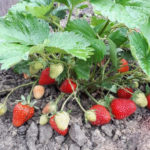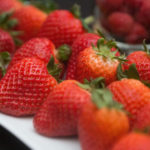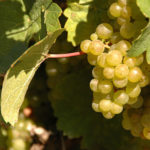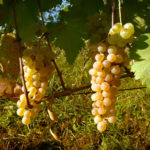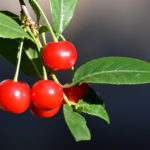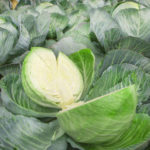Strawberry variety Pandora (Molling Pandora)
There are strawberry varieties about which almost everything is known. These are old proven "fighters" on the berry front or new items that have already become favorites and have been successfully delighting us with their excellent harvests for several years. And there are those varieties around which a "halo of mystery" is created, information about them seems to be available, but it is either very little, or it is radically opposite. This often happens thanks to the Internet, because many sites mindlessly copy data from each other, distorting them and adding something from themselves each time. The result is often simply fantastic stories that only confuse gardeners. Or they are forced to make the wrong choice of plants for planting on their site. One of these "dark horses" willy-nilly became a British variety with a 30-year history - Molling Pandora or simply Pandora. But what this strawberry really is and why there are so many conflicting data and incomprehensible characteristics about it - we will talk about this below.
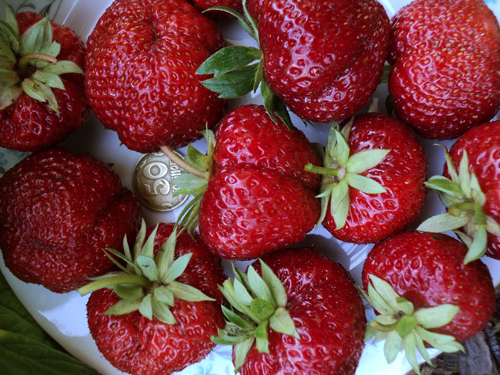
History of creation
Molling Pandora was bred by breeders D. Simpson and M. Blanke in 1988-1989 as a result of crossing varieties (Von Humboldt x Redstar) x Merton Dawn. The work was carried out as part of the East Malling Research Station program for the cultivation of new strawberry varieties. It is the largest fruit growing research institute located near East Malling in Kent, UK. This is a truly legendary station that has become the author of numerous recognized “masterpieces” among berry crops. And also released in recent years many interesting new products. She herself is worthy of a separate article, but more on that next time.
Description
Vigorous bush, spreading, well leafy. Reproduction does not represent labor - strawberries produce a sufficient number of powerful mustaches. Leaves are medium in size, on long petioles, rich light green color with a glossy sheen, slightly wrinkled, without pubescence. Pandora blooms profusely, the flowers themselves, and subsequently the berries, are located on numerous thin and flexible peduncles (already up to 10 pieces in the first year of planting), which are shorter than the leaf stalks. Therefore, even green berries lie on the ground and ripen under the cover of foliage. To simplify the collection and sanitary cleaning of plants, this, of course, is not very convenient. But since late ripening occurs at the beginning of the strong summer heat, thanks to the cover of leaves, the fruits are not baked too much. An interesting feature of the variety is that the sepals are, as it were, adhered to the berry during the growing season, and the stalk is torn off the fruit.
The berries are large, massive, rounded obtuse conical shape. The first strawberry fruits are the largest, slightly flattened at the top and bottom, their weight can be up to 50-60 grams, and the diameter is up to 6 cm. Then the berries become a little smaller, but remain one-dimensional until the end of fruiting. The average weight in the season is 25-30 grams, and the average diameter is 3-3.5 cm. The berries of Molling Pandora are bright, orange-red in color with a slight sheen, at the stage of full maturity they become dark cherry.
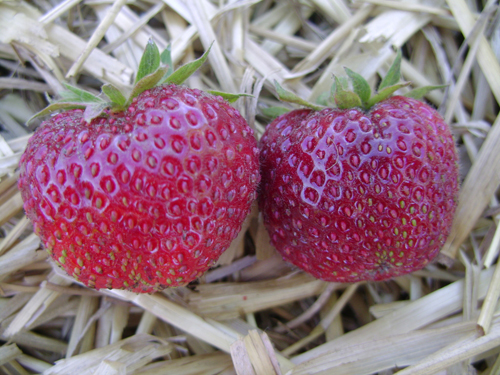
Fruits of sweet and sour, dessert taste. And now, in a fully ripe berry, all the excellent rich relish opens up. The strawberry pulp is relatively dense, but juicy, red-orange in color, with a very pleasant rich aroma. Seeds are medium in size, yellow and yellow-red in color, deeply sunk into the pulp. The skin is moderately elastic, therefore transportability and keeping quality are rated 3-4 points on a five-point scale. The main emphasis in commercial cultivation is on local markets that are close to the harvesting site. Also, the originators recommend frequent sampling so that the berry does not overripe. In overripe fruits, taste becomes the highest, and their transportability and keeping quality are low.
Pandora's pollen is sterile.This is one of the few strawberry varieties today that require a pollinator, so don't grow it without a neighbor. It is advisable to plant strawberries in parallel with this variety, which approximately coincides with it in terms of ripening. Firstly, these are the late varieties, on which the main emphasis should be placed - Adria, Malvina; mid-late - Roxanne and others. And it is also good as a safety net to have on the site and repair, constantly throwing flower stalks during the season. Type Murano, Mariguette
The beginning of ripening of strawberries falls on the end of fruiting of the well-known mid-season variety Syria. Our heroine today is one of the latest in her class, ripens five days earlier than the popular and awesomely delicious Malvina. In the south, it begins to blush from the end of June.
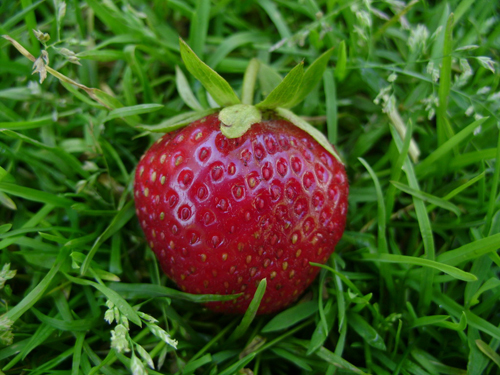
The variety is indeed very fruitful and produces a large percentage of first class berries. Pandora is very sensitive to planting dates. For successful fruiting already in the first year, it is advisable to plant it in mid-August-early September (for the southern regions). Subject to planting with high-quality seedlings and in the right time, in the first year, up to 800 grams of berries can be harvested from one plant. It is worth noting that young plants can sometimes start bearing fruit earlier than expected. In subsequent years, the yield of strawberries only increases. But on old plantings, the taste may deteriorate, the berry will sour.
In general, it is advisable to grow plants of this variety up to four years of age. You should also be wary of late-autumn planting - the plant will not have time to lay flower buds before frost and will simply drive the green mass without berries all season. It is also desirable to shelter for the winter with agrofibre (lutrasil). Pandora's bushes are voluminous, and this must be taken into account when choosing a planting scheme. It is advisable not to save space and plant with an interval of at least 35-40 cm or more between plants in a row. A distance of 50 cm is maintained between rows. The recommended planting density is up to 24,000 or less plants per hectare.
Molling Pandora is not very demanding on nitrogen fertilization, but he loves the soil saturated with organic matter very much, and regular watering is also necessary in an amount sufficient for the plants. The emphasis during the ripening of strawberries should be on fertilizers with a high potassium content, which is necessary for the good quality of a huge amount of pouring fruits.
The berries are resistant to decay, even in rainy and cool weather, they can lie quietly on the ground for a couple of days. But in extreme heat (especially in the southern regions), the fruits can wither. The variety is resistant to powdery mildew and wilt, moderately resistant to fusarium wilt. Quite susceptible to spotting and late blight root rot.
The berries are great for the fresh market and for personal consumption in their natural form, but are also suitable for processing and freezing. Especially captivating is the fact that, thanks to the late ripening period, you can benefit from the price when selling strawberries. When there is no longer a mass shaft of "penny" berries on the market, the harvest from early and mid-season varieties is practically removed, Pandora enters the scene with its very high yield, rather good taste and quality of fruits.
At the end of the article, I would like to summarize all of the above and clarify all those contradictory and incomprehensible points that this variety has.
- Confusion with the name. Many varieties of East Molling Station have two words in their name. One of them is the same for all - Molling (Molling Opal, M. Century, M. Juno's raspberry, M. Minerva).And it is correct to call plants just such a phrase, since otherwise the meaning may be lost. The same thing happened with our heroine, and some gardeners mistakenly believe that Pandora and Molling Pandora are two different varieties.
- Positioning this strawberry as the latest. In fact, this is not the case. She is one of them, but now we have the latest ripening Malvina on the market, it ripens 5 days later.
- Pollination confusion. Our heroine needs pollinators. Because of this (frankly unpleasant and inconvenient) feature, many people are afraid of it, others do not fully understand this point and do not know how best to solve this problem, and some believe that strawberries bear fruit well without additional pollination. We responsibly affirm (this is also stated by the originators) - Pandora needs one or several late or mid-late pollinating varieties.
- Disputes over taste. Not everyone has the taste and sweetness of berries, sometimes they resemble grass. Well, what to do. This means that the growing conditions and soil did not fit, in different regions in different areas the plants behave differently. You can try changing the power plan. But for a larger percentage of gardeners, strawberries are tasty, aromatic and sweet even in rainy and cool weather.
- And of course, Internet hackers who consider themselves "professors", copying data from each other and writing implausible descriptions. What is just the phrase in some articles about Pandora that the popular varieties "Fragaria" and "Ananassa" were taken for crossing. It only brings up a sad smile. How can you write about the characteristics of strawberries without knowing the elementary - that Fragaria x ananassa is the name of large-fruited strawberries in Latin, it is also garden strawberry. In short, we all love strawberries.
As a result, we can say that Molling Pandora can really take its rightful place on your site, subject to the availability of pollinating plants. And a plentiful late harvest of beautiful, tasty and fragrant balls-fruits will not leave anyone indifferent!
Author: Maxim Zarechny.
